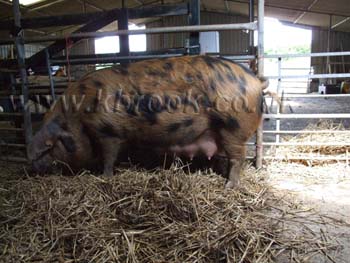PIG BREEDING
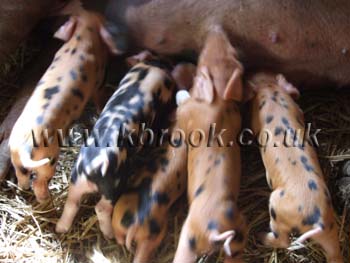
Pig breeding is a subject that fills people with excitement and has the OOOO and AHHH factor. I so often take phone calls from excited and enthusiastic people who claim to have “always wanted pigs” and want to own a breeding gilt or two, or may have been advised to have a sow in pig so they don’t have to wait. It is my opinion and of which I also advise the enthusiastic people that this is not the way. I have heard so many failing stories of people who would not or could not or did not want to wait, stories of litters dying, the sow dying during birth, ailments that they were unable to deal with because they were not proficient in identifying the problem early on or thought “oh it will go away if we leave it for awhile”. Then there are those that go to the markets and purchase a sow with piglets, or a sow in pig or some fattening pigs, I am not saying don’t go to these markets but take someone with you who knows what to look for and can advise you. As people new to pig keeping are so easily sold too and you could come back with an aggressive sow, a sow that was most probably sold because she no longer produces good litters or at worse is barron. You could purchase piglets from the market for fattening and find you get them home and they have ailments that are a cost you had not allowed for. So be on your guard and take someone experienced with you.
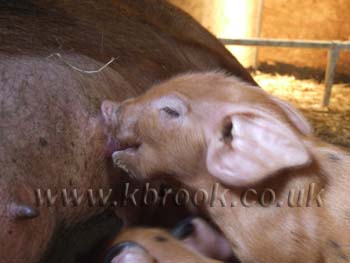
On receiving phone calls filled with enthusiasm many of you are, which I am pleased about, have come to me after attending Gillian Dixon's Pig Course, whereby you already have the structure and knowledge in place. But those of you who come to me with the same enthusiasm have not been on the course my advice will also be the same. I encourage you piggy people to come and see my set-up, see what I do and how I do it. Answer any questions you may have, show you the mothers, how they are kept outside and how I manage my girls. I also advise that if you have never kept pigs before to take two for fattening first this way you will have a feel (although not the full experience), and the dedication that is required for the first few months before they go to slaughter, acquiring suitable housing, feeding, regular contact and the insignificant situations, for example comparing the types of soil and coping with the eventualities that come from this and stimulation and so it goes on.
I do not agree with individuals that encourage those of you new to pig keeping purchasing a sow in pig. And the reasons are thus (which are all experiences I have had the regret of being told): On moving a sow or gilt in pig and depending on how far into her term she is has proven to be a very distressing time, resulting in the sow aborting; also moving a sow or gilt in pig to new surroundings with new people together with totally unfamiliar surroundings is also distressing resulting in the sow/gilt in pig to become aggressive towards the new owners (not exactly a good introduction and encouragement the first timer would wish to encounter rather a baptism of fire), the sow/gilt dies during farrowing (reasons could be ten-fold, for example, the sow was knowingly sold with the underlying ailment, or she could have been too old) or knowingly has small litters. Also, in retrospect, why should pig keepers sell sows in pig? Yes it is done and to the experienced pig keeper it is no problem at all, this is done to order for the experience pig keeper. But those new to pig keeping, you should be asking why is there a sow in pig for sale, perhaps if you are interested in going down this avenue take someone experienced with you who knows what they are looking for and is able to ask the right questions for you.
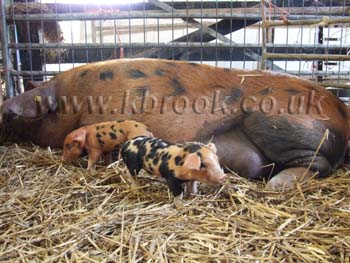
But the best advice is, grow with your herd so they know you and you know them they interact with your voice and your body language as you will with theirs watching them grow and knowing their quirky little ways and their grumpy moods and at the same time knowing your limitations.
So after all my waffling, your decision is to pig breed. The Oxford Sandy & Black is a wonderful, gracious, pleasing pig with an excellent temperament, is an all rounder, has excellent mothering skills and a good outdoor pig who does not suffer sun burn apart from the piglets on their little ears but nothing that factor 50 sun cream can not help with. The boars are equally sound and of good nature.
Please when looking to breed it is important if you can pop and see the owners of your potential weaners and all us piggy people are very accommodating and if one cannot help then we will surely put you in touch with someone who can. You may be too far from some of us just to pop in. But having said this it is worth travelling for good Oxford Sandy & Black pigs regardless of sex. It is also worth seeing a couple of us Oxford Sandy & Black pig breeders so you can get an idea of how one persons ideas differ from the other and how the combination of all the breeders you have seen can work for you.
If you are keeping pigs as a business you will also most certainly be involved in breeding. Some people choose to run “finishing units”, where they buy in stock that other people have bred and then raise it to slaughter age, but most people keep their own breeding animals and have a programme for litter production. Some of the issues to consider in relation to breeding are the following:
- What level of activity you wish to engage in – You will need to decide whether you wish to be very small scale or engage in larger-scale production.
- Acquiring breed stock – do you wish to produce breeding or show stock or both, or do you wish to produce solely for meat. Basically, to produce high quality pigs you will need to choose the best you can find and afford. If you are producing meat, your breeding sows do not have to be of top show standard, but they will still need certain qualities and it costs as much to keep a poor specimen as a good one, so it is still worth getting the best that you can.
- Whether to keep a boar – you will have to have at least 4 females to keep a boar happy. Also, as I may be stating the obvious, boars are larger and more dominant than females and also grow tusks, so you will have to be a little cautious about how you handle them. The tusks will have to be clipped say once a year so they do not cause damage to their companions in the pen, to themselves by getting caught up in fencing and also by accidentally catching you as they turn round to give you a gentle rub on the leg! Boars are quite capable at servicing from seven months, although I did hear of a boar that was 6 months of age and was very capable! Sperm is produced at around 19 weeks and is developed in the testes at between 24 and 27 weeks depending on breed. Whilst on the subject of pig sperm – sorry – an interesting factor I read recently was this; around 200cc of seminal fluid is delivered when servicing a sow compared to 5cc when a bull is servicing a cow and 1cc from a ram when servicing ewes. Suitable age for a boar to begin servicing is at least ten to twelve months old. They are then sexually matured with their testes fully formed and fully functionable.
- Knowing when your sow/gilt is ready to be serviced. The rule of thumb is that females come into season every twenty-one days, having said this like us humans we are all different. Out of my girls one is like clockwork, every 21 days however the other comes in every 18 days. The correct term for coming into season for pigs is “hogging” or “brimming” and this is evident by the age of six to seven months (but they should NOT be bred from at this age) and bred from at twelve months this is because they are sexually mature and also giving time for their reproductive organs to be fully formed.
- Brimming/Hogging. As mentioned this is when the Female is in season. You will notice that her vulva will become very swollen and on her fourth or fifth day she will be ready for the boar. Her personality will change a little. For example with my “clockwork” girl she will come into season on the 21 day and on her first day of hogging she will not come out of her arc but stay in having a lie-in whereby I will go away with her food and come back in the afternoon to feed her then on her second day of her season she will come out and is receptive and eats as normal and this will continue until her fifth day whereby all she wants me to do is feed her give her a little tickle and leave and by the seventh day it is all over and we are back to normal again. My other girl will however come into season on the 18 day and will be totally normal until her fourth day and will just have me feed her and make sure I leave her pen and this will go on for three days and then we will resume back to normal.

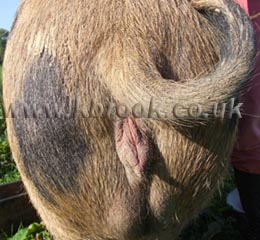
- Servicing. The females are receptive to the boar two to three days and it is imperative that they are with the boar during this time. When the female is standing the boar will serve her and will tie from between ten and thirty minutes. When the female is left with the boar you will notice that she will be serviced more than once of the duration of her season. Ovulation occurs thirty six hours after the season begins and an average of sixteen eggs are released each season although this can vary from ten to twenty five according to breed, age nutrition and percentage of in-breeding. Be aware more than one boar can service a female in any given season and if by any chance your females have contact, accidentally, with two boars, she could produce a mixed litter and if you are producing pedigree pigs this could cause major problems with registrations.
